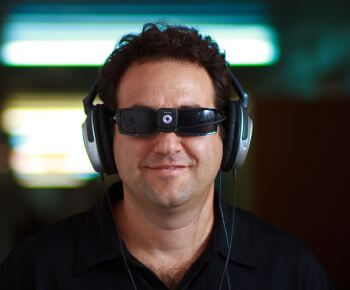The results of the study, recently published in the prestigious journal Cerebral Cortex, reveal that in response to the sounds of the sensory transduction, activity of the visual areas was recorded in the blind from birth

Scientists from the Hebrew University managed to connect to the visual cortex of the blind from birth with the help of sensory substitution devices (SSDs - sensory substitution devices) that allowed the blind to "see" and even describe objects. These are non-invasive devices that provide visual information to the blind through the other senses. For example, in a sensory transformation from sight to hearing, blind people put on glasses on which a tiny camera is mounted that is connected to a computer and hear through headphones a "translation" of the images into sounds. The images are converted into a "soundscape" with the help of an algorithm, and this allows them to listen to the visual information and interpret it.
The study conducted by research student Ella Shetrim-Amit under the direction of Dr. Amir Amadi, from the Edmond and Lily Safra Center for Neuroscience and the Israel-Canada Medical Research Institute, showed surprising results - blind people who received relatively short training were able to use the device to locate people, identify complex objects and the body theirs, and even read letters and words.
The results of the study, recently published in the prestigious journal Cerebral Cortex, reveal that in response to the sounds of the sensory transduction, activity was recorded in the visual areas of the blind from birth, and this activity even followed the pattern of action that characterizes the sighted - separate visual processing in two visual pathways.
It has been known for about thirty years that the brain processes visual messages in two separate and parallel pathways - one pathway processes the shape and color of objects and identifies them and the other pathway processes information regarding the location of the objects in the world and helps in planning the movement towards them. This functional division has been studied a lot, but until today it was not known what the role of the evidentiary experience in the creation of this structure was.
"Our research revealed that the visual cortex of the blind operated in a similar functional division when the information was transmitted through sounds," explains Dr. Amadi and adds: "These findings demonstrate that the functional division into two pathways, which is of great importance in the vision process, can develop, at least partially, even without experience I saw This means that it is possible that this division is not evident at all in its essence".
Other studies have recently shown that different areas of the brain are not sensitive to the sense from which the information comes, but rather to the specific task or processing they perform, and these can be stimulated through different senses. Following on from these studies, the study by Shtrim-Amit and Dr. Amadi adds an important layer to the claim that the entire brain may be task-focused and not sensitive to a particular sense. "The brain is not a sensory machine, although it is sometimes perceived as such. He is a task machine", concludes Dr. Amadi.
The researchers claim that it is possible to learn from these findings that it is possible that the brains of blind people, even those who suffer from prolonged blindness, can "wake up" to process vision with the help of rehabilitation that also includes new and future medical developments such as retinal implants (artificial eyes). A summary of these ideas was recently published in the respected journal Current Opinion In Neurology by Dr. Amadi and the students Lior Reich and Shahar Meidenbaum from this laboratory.

4 תגובות
Peace to my father
What about the possibility of allowing the deaf to hear using "mirrors"... is this also being worked on?
To Ronen,
It is true that this is a continuation of an old topic that was done in the past in different configurations, but there are innovations here mainly in the research surrounding brain activity.
Oh well, but it's already so old, I read about it a few years ago and there are also some videos on the subject on YouTube.